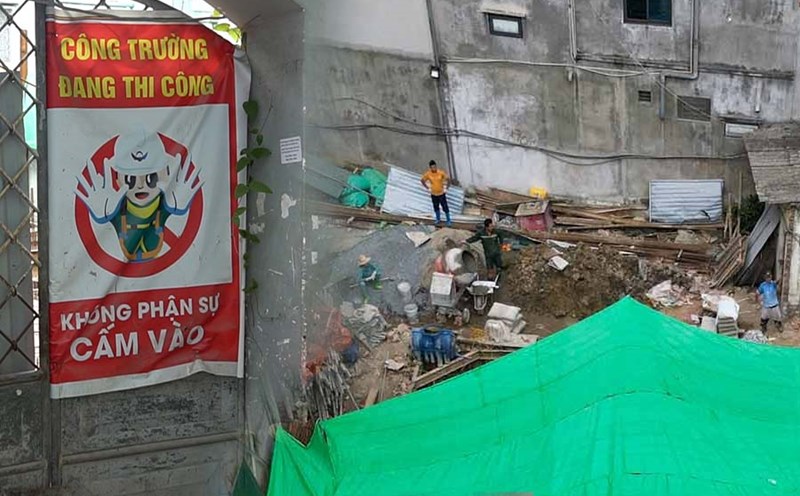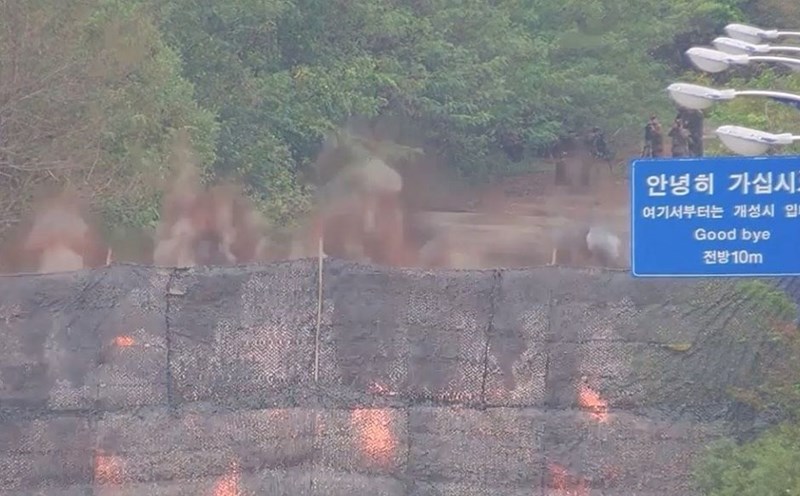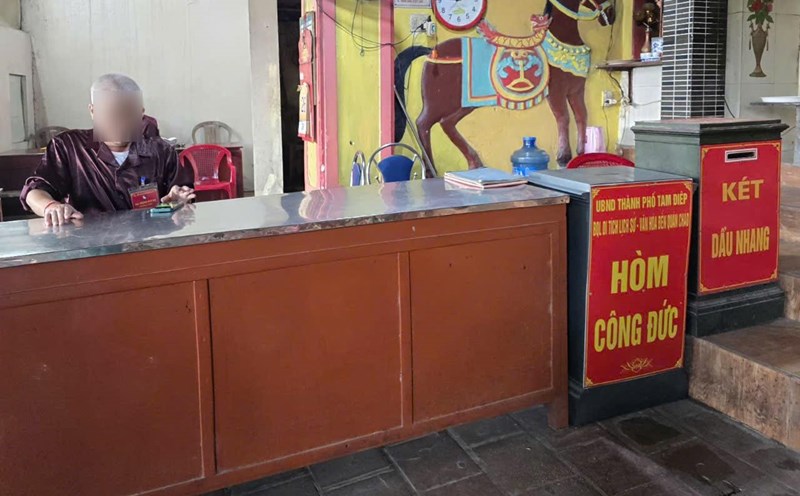What leads to controversy?
Unlike Thai Hoa Palace or Chua Cau with hundreds of years of history, the villa at 49 Tran Hung Dao Street (Hanoi) - with more than 100 years of age and originally a private house - has also caused a storm of controversy. on media and social networks, with the participation of all social sectors.
It should be remembered that this is just a sample remodeling project, to serve as a foundation for the remodeling of 91 other old villas built before 1954 in Hanoi according to Decision No. 1845/QD-UBND of the People's Committee. People of Hanoi city, replacement document for Decision No. 7177/QD-UBND issued on November 28, 2013.
Right from the time the restoration work was not completed, but in the embellishment and renovation project of the villa at 49 Tran Hung Dao Street, it was criticized for the paint color and changes to the external structure. This villa is considered one of the typical works of French architectural style in Vietnam.
However, in essence, this is a private villa built for residential purposes, so there are no records of public architectural works. Before renovation, the villa was abandoned for a long time, so many items were seriously damaged or completely broken.
By 2016, the villa restoration project began to be researched, evaluating the structural condition, and exploring the original material layers by cooperation between Hanoi city and the Ile - de - France region, Hoan Kiem district. Sword and the Ile - de - France Region International Cooperation Agency. The renovation will be implemented in April 2022.
The process of renovating the villa was done seriously and thoroughly, however, it was criticized for "the paint and red bricks are flashy and inappropriate, ruining the antiquity of the building" or " If the window edges along the staircase are removed, the original architecture will be lost."
The unit performing the restoration affirmed that it had thoroughly explored the layers of materials to find overlapping layers of stucco and original paint; The paint color and color scheme were restored exactly to the 1915 color photo of the villa by photographer Leon Busy.
Regarding the removal of window lashes along the staircase, Mr. Emmanuel Cerise, Director of the Paris Region International Cooperation Support Agency in Vietnam (PRX-Vietnam) also said that "the lash structure is a derivative of the following "This is not in French architecture" so removing it was a reasonable decision.
The new paint color and appearance of this villa are the cause of controversy, leading to the thesis of "rejuvenating monuments and heritages", or "turning "hundred-year relics into 1 year". It is exactly like the golden lapis tile roof of the Thai Hoa Palace or the paint layer of the Covered Bridge or the decorative motifs on the roof and the new wooden slats in the beams.
It can be concluded that the cause of controversy and opposition lies mostly in the shell of the monument, when newness causes resistance to old concepts, mossy, full of overlapping sediments. Suddenly one day, an old, familiar image disappears, people feel "annoyed, sad, and need to speak up".
Consequences of lack of background knowledge and expertise
The way we perceive heritage is not based on a basic understanding of heritage and heritage restoration work, two fields that require specialized knowledge such as history, architecture, and materials. Materials, construction, planning... are the basic causes of controversy.
The way an ordinary person views an architectural work with historical or cultural value is completely different from the view of an architect or a conservation or museum expert. People without expertise only see a heritage as beautiful and precious, but do not know how beautiful or precious it is.
Villa No. 49 Tran Hung Dao is simply a house, not a monument or related to any historical person or event. Of course, it is material evidence of the French period in Hanoi, like the Covered Bridge in Hoi An or the Chinese assembly halls in many places.
For the majority of public opinion, this is just a vague pride. Many Hanoians passed by that desolate French villa thousands of times with indifference and only became interested and excited when it was renovated. In many other French villas, residents also destroy and deform the architecture to serve space needs.
Covered Bridge and Thai Hoa Palace are a little different, because they are public works and are part of the larger complex of Hue Citadel and Hoi An ancient town. But anyway, they are all "protected" objects of a vague pride of the masses, who have almost no function to preserve and protect.
However, the vague pride mentioned above is the motive that gives rise to controversies related to the restoration of historical relics. Participating in contributing opinions, criticizing and supervising the embellishment, restoration and preservation of heritage by all social sectors is valuable and necessary, however, it needs to come from a positive and positive attitude. Basic understanding of heritage.
Objectively speaking, there are many debates about the restoration of these heritage sites and relics by famous people that attract a large amount of attention on social networks, reflecting a permanent mentality of weakness in the community. intellectual and popular classes in society.
This petty mentality arises from inferiority in the face of Vietnam's "relatively poor" architectural treasures, which are not commensurate with the thousands of years of history of the nation and the country. We have very few architectural heritages that can make Vietnamese people proud internationally.
Therefore, the French architectural system and colonial period constructions such as: Opera House, Cathedral, Long Bien Bridge, Tonkin Palace in Hanoi; International urban traces such as Covered Bridge and Phuc Kien Assembly Hall in Hoi An; The Governor General's Palace of Indochina, Notre Dame Cathedral, and Chinese Assembly Halls in Ho Chi Minh City have become possible anchors of pride.
Therefore, all changes related to these heritages make public opinion especially concerned, and ready to argue to "protect the old beauty" of the heritage. Invisibly, that reaction has become an unconditional reflex of the people, considering them as inviolable property.
Especially in the social network environment, when all opinions can be expressed easily and irresponsibly, it fuels useless professional debates between supporters and opponents. embellishment, restoration and preservation of heritage.
As a result, many times the government and experts are "afraid" of the wave of protests in the media and social networks, so there is also the phenomenon of "following public opinion" or "plowing in the middle of the road". full of confusion and caution.
It is necessary to have a standard eye for heritage
From beautifying and preserving previous works such as whitewashing the Opera House, repairing French villas, embellishing and repairing Cau Pagoda, restoring Notre Dame Cathedral or restoring Long Bien Bridge in the future, we It can be seen that the controversial issue is whether the project has been embellished and preserved in its original form and is it beautiful or not?
However, whether the answer is right or wrong, it is not the core and purpose of heritage preservation. In heritage conservation, there are many types of conservation such as: Preserving the original state; preserve the future evolution of the heritage; restored to its original integrity.
Therefore, when embellishing and preserving a certain heritage, experts make a clear distinction to communicate to the people what kind of purpose is the purpose of preserving this heritage, and therefore what the method of proceeding will be. so that people will not be shocked when they see a "brand new Covered Bridge".
They also need to have a flexible mindset in dealing with heritage to better suit the new surrounding context, without losing the main values. And above all, it is necessary to clearly classify groups of architectural heritage in order to appropriately address them.
Therefore, to classify items of restoration and embellishment of monuments and heritage, we need a professional heritage eye from archaeologists, historians, architects and heritage conservationists.











